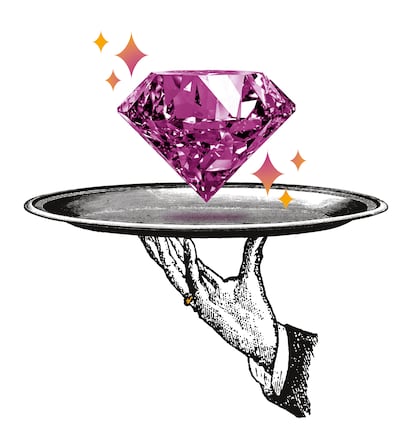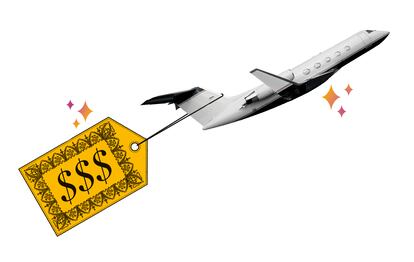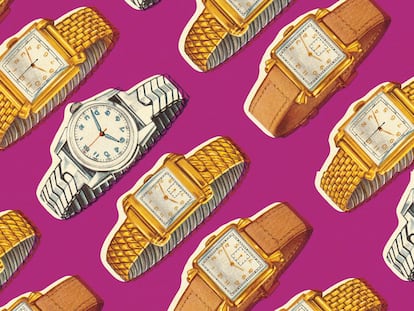Breaking record after record: The stellar figures of the ‘premium’ market
The luxury industry has a higher turnover than ever despite economic uncertainty and could close 2023 with a record value of $1.6 trillion, between 8% and 10% more than last year. But is this phenomenon sustainable?

The latest version of the Speedy, one of Louis Vuitton’s most famous bags, costs one million euros. It is made of crocodile skin and has a gold chain and a padlock set with small diamonds. Don’t look for it on the brand’s website: the Speedy is only sold to order. It is a whim reserved for a few, but it symbolizes the power of an industry that is turning over more money than ever despite the current economic uncertainty. The luxury bubble has been immune to economic turbulence in recent times. Although some wonder if the boom is sustainable, since certain elements have been detected that point to a slowdown, the forecasts for the high-end market as a whole are mostly positive.
The super-rich are spending more and more and from a younger age. The global luxury market suffered a slowdown in 2020 due to the pandemic, but since then it has grown strongly and is already above the levels before the coronavirus hit, despite the shadow of recession and inflation posing a threat to the global economy. Consulting firm Bain & Company published forecasts in November that predicted the premium market reaching a record value of $1.6 trillion, which is between 8% and 10% more than 2022, which also broke record values. “Although there are some challenges on the horizon, such as the fragility of consumer confidence and macroeconomic tensions, the industry has demonstrated that it is strong and adaptable, and is prepared to continue growing in the long term,” says Claudia D’Arpizio, one of the company’s partners. “Consumer trends have evolved, with a notable emphasis on experiences, which have taken spending to historical highs,” adds Federica Levato, another partner.
The Bain report, carried out together with the Italian association of luxury producers Altagamma, includes nine categories: personal goods (fashion, jewelry and watches), cars, travel, wines and spirits, gastronomy, decoration and home products, art, private planes and yachts, and luxury cruises.
The generational factor is paramount. Younger consumers have become a major driver. Thus, millennials (born in the eighties) and generation Z (born in the late nineties) are credited with almost all the growth in 2022 and this trend is expected to continue in the coming years, according to Bain. Younger and younger generations are purchasing luxury earlier and earlier.
“The consumer profile varies depending on their age and place of origin,” says Xandra Falcó, president of Círculo Fortuny, an association that brings together 70 Spanish brands and cultural institutions with connections to the luxury sector. The demand for sustainable products and services is increasing, and in all generations. “New consumer groups are also emerging, such as the so-called ‘quiet luxury’, which is associated with customers who really know about a category and look for quality, design, origin, and not a flashy logo,” she adds. In a study carried out in collaboration with Círculo Fortuny, which has just been published by the consulting firm McKinsey, the Spanish high-end market is estimated to have had a turnover of €17.7 billion ($19.2 billion) in 2022, which represents 4.5% of this sector in Europe. “Between 2017 and 2022, growth in Spain has been 2%. Despite the decline during 2020, it has seen a rapid recovery, driven mainly by the increase in experiences,” explains Ignacio Marcos, senior partner at McKinsey.
Rising prices
The rise of luxury around the world has resulted in an extraordinary increase in prices in recent years. Inflation and rising costs, especially after the outbreak of the war in Ukraine, have impacted the entire economy, and luxury is no exception. According to data from the market analysis firm Edited, prices have risen more than 25% since 2019. Chanel bags, for example, are twice as expensive as in 2016, as recently highlighted by The New York Times in an article in which it showed its astonishment at the case of the brand’s classic 2.55: in 2008 it sold for $1,650, and 2023, the figure has reached $10,200.
The case of the new million-dollar Louis Vuitton bag is an extreme example of price increases. It is not surprising that Bernard Arnault, the owner of the prestigious brand, is one of the world’s richest men. The fortune of the president and largest shareholder of the French luxury giant LVMH, which also includes Dior and Celine, is estimated to be $192 billion, which makes him the second-richest person in the world, behind Elon Musk. As if that were not enough, in April, LVMH managed to be the first European company to surpass the half a trillion dollars mark in terms of stock market value.
But the French tycoon’s emporium has deflated since then (its price is now around €360 billion/$391 billion) and its third quarter results show a slowdown, as has happened with other companies in the luxury industry. LVMH’s revenue, which is seen as a barometer of the sector’s health, grew at a much slower pace than expected. The reopening of China at the beginning of the year, which was the last major country to lift Covid restrictions, suggested a large increase in luxury spending, but the weakness of Asia’s largest economy has slowed the trend slightly. Signs of slowing down have also been detected in the French group Kering, founded by the Pinault family and owner of brands such as Gucci, Balenciaga, Bottega Veneta, and Yves Saint Laurent, and in Richemont, the Swiss luxury goods company that owns Cartier and Van Cleef & Arpels.
Experts are not denying that there may be a slowdown, and that the party is over for records and extraordinary growth, but they agree that the sector is strong. “The industry is well positioned for the long term, with a strong base and the convergence of the different luxury markets,” Federica Levato, the Bain expert, predicts, and she highlights that uncertainty in the global economy is very high. For Spain, McKinsey predicts an increase in the high-end sector of between 7% and 9% next year, depending on the level of recovery in the tourism sector and the economic and global impact on demand.

First class on the plane
Tourism is one of the pillars on which the future of the luxury sector is based. Major airlines are boosting their business and first class availability as a profitable revenue channel fueled by booming demand. There are even more users of private flights. Meanwhile, luxury hotels are proliferating and even the all-inclusive has also become a “premium” experience.
“High-end travelers value more participatory trips, such as excursions to remote and exotic places or exploring a place while connecting with the local culture,” explains Pablo del Pozo, president and CEO of the luxury travel agency Nuba. “To talk about the most luxurious trip, we must first define what luxury is. We see it as something that is personalized, unique, and exclusive,” from space travel to “experiences with famous people or in memorable places.” An example would be “an expedition to the White Desert of Antarctica aboard a state-of-the-art airship, or with accommodation in air-conditioned capsules designed to the millimeter for luxury and comfort.” Del Pozo explains that, for between $100,000 and $500,000, there is “a wide range of luxury products and services that can be offered,” such as going to the Amazon with an expedition guided by scientists.
Regarding luxury experiences, from hotels to gastronomy, wines, sports, nautical travel, and decoration, Spain knows a lot, since this sector represents almost half of the national high-end market. “The opening of luxury hotels increased by 40% in 2022, and in this sense, consumers’ interest in spending on experiences and trips has exceeded all expectations,” Xandra Falcó explains. “Within the range of experiences, the wellness and personal well-being sector has experienced 10% annual growth, spurred by millennials and generation Z, but also by boomers,” she adds.
Every day, people of all ages walk through the Canalejas Gallery, a few meters from Puerta del Sol in Madrid. Opened just over a year ago, it houses the major luxury brands’ retail stores. A door connects the exclusive shopping mall with the Four Seasons hotel, where the average nightly rate is close to €1,000. “We are proof that Madrid has turned its potential to develop the luxury market into a reality,” says César Glaría, the gallery’s marketing director.
Brands such as Dior and Hermès and others that until now did not have a store in Spain, such as Jil Sander and Stefano Ricci have retail spaces at the mall. “Our clients are mainly tourists, especially from the United States and Latin America, but also from China,” he explains, while showing the large private room where VIP clients are served personally. They are greeted with a bottle of Cartier champagne, which is only produced in very limited editions. From there they can try on and buy whatever they want, of course, without having to go to the stores themselves.
Sign up for our weekly newsletter to get more English-language news coverage from EL PAÍS USA Edition
Tu suscripción se está usando en otro dispositivo
¿Quieres añadir otro usuario a tu suscripción?
Si continúas leyendo en este dispositivo, no se podrá leer en el otro.
FlechaTu suscripción se está usando en otro dispositivo y solo puedes acceder a EL PAÍS desde un dispositivo a la vez.
Si quieres compartir tu cuenta, cambia tu suscripción a la modalidad Premium, así podrás añadir otro usuario. Cada uno accederá con su propia cuenta de email, lo que os permitirá personalizar vuestra experiencia en EL PAÍS.
¿Tienes una suscripción de empresa? Accede aquí para contratar más cuentas.
En el caso de no saber quién está usando tu cuenta, te recomendamos cambiar tu contraseña aquí.
Si decides continuar compartiendo tu cuenta, este mensaje se mostrará en tu dispositivo y en el de la otra persona que está usando tu cuenta de forma indefinida, afectando a tu experiencia de lectura. Puedes consultar aquí los términos y condiciones de la suscripción digital.
More information
Archived In
Últimas noticias
Most viewed
- Sinaloa Cartel war is taking its toll on Los Chapitos
- Oona Chaplin: ‘I told James Cameron that I was living in a treehouse and starting a permaculture project with a friend’
- Reinhard Genzel, Nobel laureate in physics: ‘One-minute videos will never give you the truth’
- Why the price of coffee has skyrocketed: from Brazilian plantations to specialty coffee houses
- Silver prices are going crazy: This is what’s fueling the rally











































